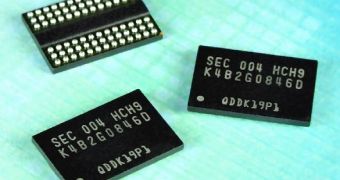Central processing and graphics processing units aren't the only chips that get landed with more advanced manufacturing processes. In fact, the memory industry is advancing quite fast itself, and Samsung seems to do a great job at proving this by efficiently moving on to smaller nodes. Most recently, the company announced that it had begun mass-producing the 'industry's first' 2Gb Green DDR3 based on the 30 nanometer technology.
Data usage has increased sharply over the past few months, especially in the field of smartphones, and this has led to a much heavier data center traffic. Such developments always warrant more memory, and a more advanced process comes in useful in such situations. Compared to the 50-nm class technology, the 30nm Green DDR3, according to the press release, enables a 155 percent productivity boost, as well as power savings of about 20 percent. The 2Gb chips will allow server memory modules to reach 1.866 gigabits per second (Gbps) at 1.35 volts, and PC modules to attain clocks of 2.133Gbps on 1.5 volts.
“We’re seeing a sharp rise in demand for DDR3 chips and are meeting that need with the timely introduction of 30nm-class Green DDR3 solutions,” said Soo-In Cho, president, Memory Division, Semiconductor Business, Samsung Electronics. “Thirty nano-class DDR3 DRAM will deliver the most satisfying user experience possible, offering extremely high performance and reduced power consumption for PC and server applications designed to capitalize on new multi-core processors.”
Overall, 30nm DDR3-based modules will be about 3.5 times faster than DDR2 and 1.6 times faster than 50nm class DDR3. Servers optimized for cloud computing and virtualization applications will especially benefit from the new memory. Samsung also hopes to bring out 4Gb chips by the end of the year, something that will let it make 4GB, 8GB, 16GB and 32GB 30nm-class RDIMMS for servers. Needless to say, 2GB,. 4GB and 8GB UDIMMs for workstations and desktops PCs are also planned, as are SoDIMMS of similar capacities for all-in-one desktops and laptops.

 14 DAY TRIAL //
14 DAY TRIAL //